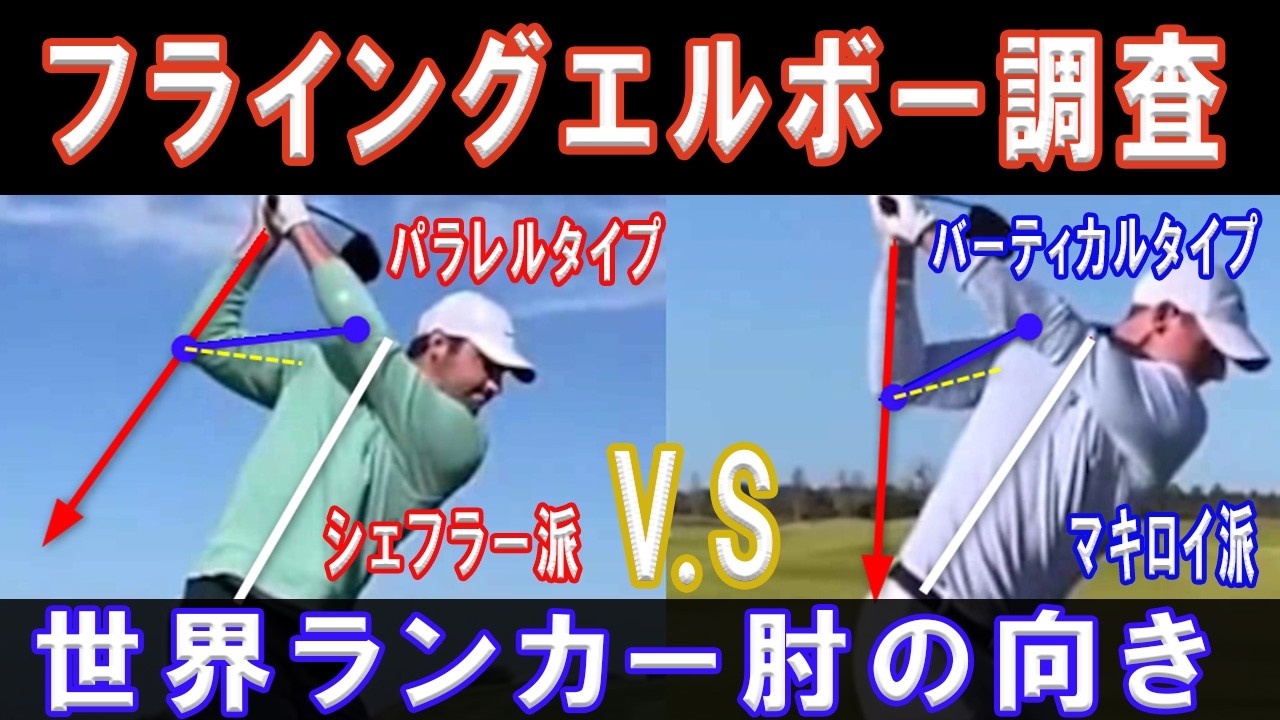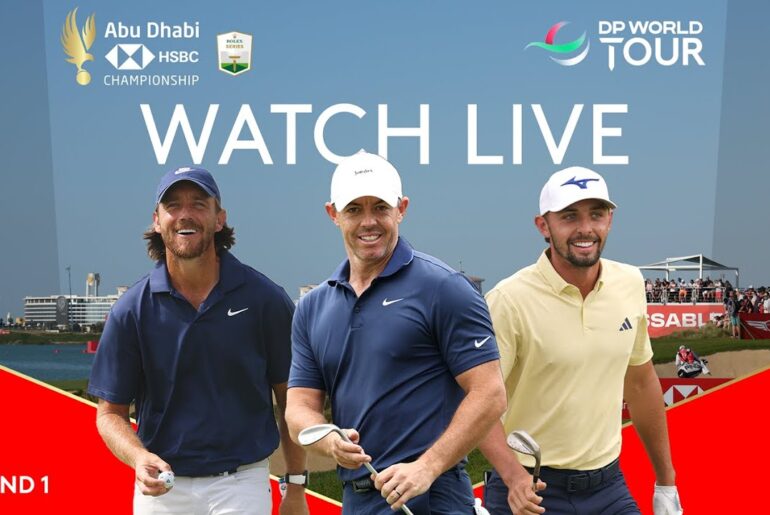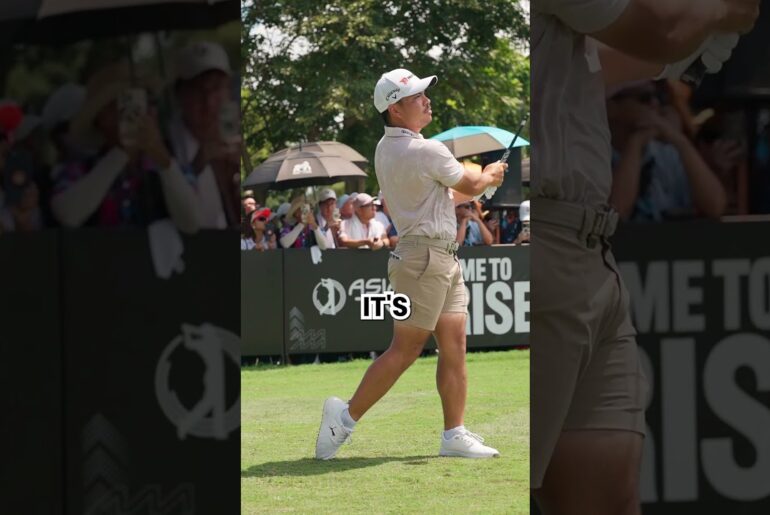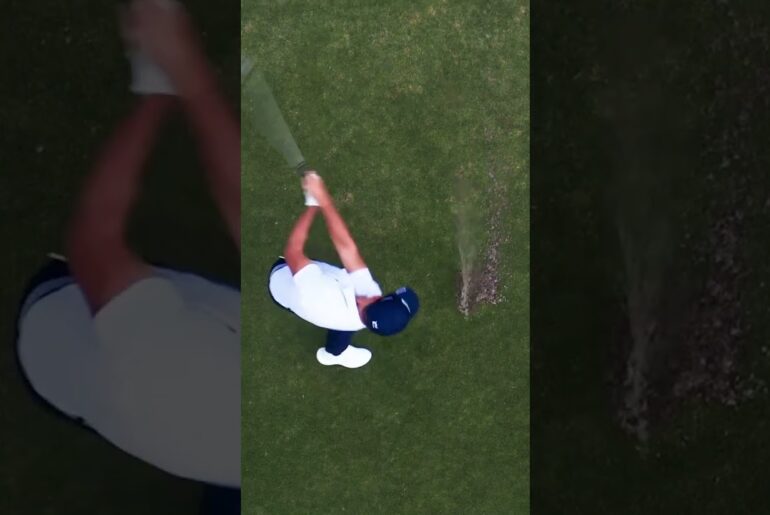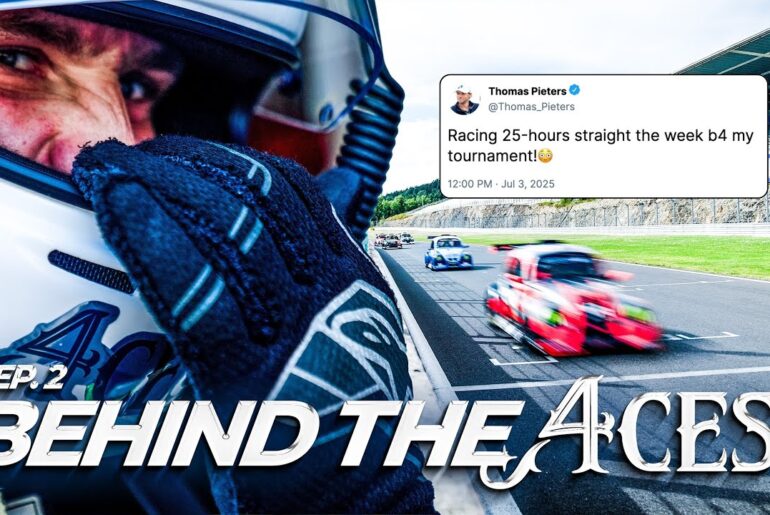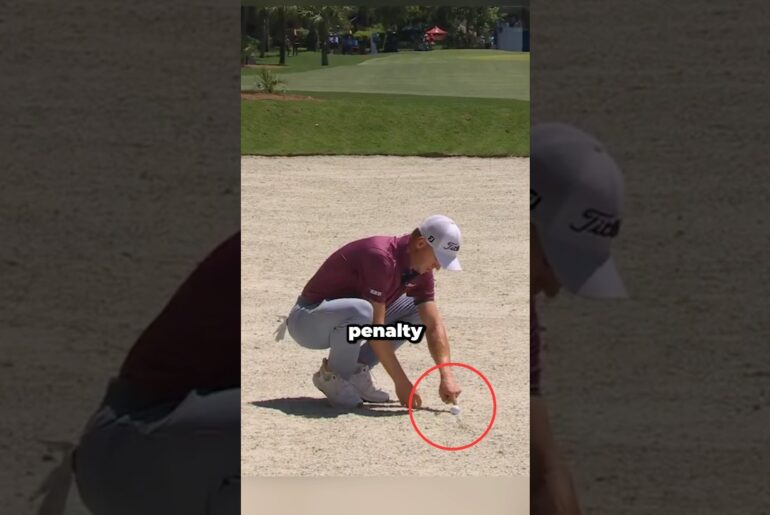ゴルフラーニングスクエア グロス 田中振一朗がお届けする「トップでのフライングエルボの真実」検証動画。2024年度世界トップ30+松山&金谷を含む32名のスイングを分析し、トップでの右前腕の角度(パラレル/バーティカル/フライングエルボ)、両肘の高さ、右肘と右肩の関係を統計的に解説します。流行に流されない「安定するトップ」の共通点と、フライングエルボを直す原因解説+実践ドリルまで、科学的かつ実用的にまとめました。
この動画で得られること
世界トップ選手32名の「トップでの右肘」の実測傾向が分かる
フライングエルボは本当に主流かどうかの結論(結論:32人中フライングエルボは0)
トップで安定するスイングの共通点(右前腕は前傾に対して平行〜地面寄り、右肘は左肘より低く、右肩より低い)
フライングエルボの主原因と心理的イメージ(右手に力を入れすぎる)
即効性のあるドリル2種類(右肘に左手を掛けるドリル/ヘッドカバーを脇に挟むドリル)と練習の進め方
「力を抜く」「腕の外旋・内旋の原理」を使った根本修正法
目次(主要ポイント)
0:00 挨拶と番組紹介
0:27 検証の目的と対象(世界トップ30+松山・金谷)
1:04 角度の分類方法(パラレル/バーティカル/フライングエルボ)と検証内容説明
3:04 各選手のタイプ別解析
9:02 分析内容説明と統計結果のまとめ(32人の分類)
12:32 集計結果から暴かれた現在主流のトップとは?
13:02 フライングエルボーの原因とは?
16:41 フライングエルボーの直し方ドリル2種
18:03 スイングの基本原理(腕の外旋と戻り)と反復練習のコツ
20:34 おわりのごあいさつ
実践ポイント(短く覚えるコツ)
イメージは「イヤンバッカーン」ではなく「イヤンバッカーン」が良い(右肘を絞るイメージ)
「この野郎!」式の右手主導はNG、腕の力を抜いて外旋を使う
ドリルはトップ付近まで右肘を閉じる感覚を覚えるために短時間反復でOK
オススメの練習メニュー(初心者〜上級者)
1週間プラン:毎日5分ドリル(左手で右肘を引っ掛ける30回+ヘッドカバー脇挟み10スイング)
目標:2週間でトップの右肘の開きが改善され、方向性が安定すること
この動画が向いている人
フェースコントロールや方向性を安定させたいゴルファー
トップでの肘の形に悩むアマチュア
科学的・統計的根拠でスイングを理解したい指導者・選手
チャンネル登録とお願い
動画が参考になったらぜひ「いいね」と「チャンネル登録」をお願いします。次に暴いてほしいテーマがあればコメントでリクエストください。リクエストに沿ってさらにデータ解析を行います。
ご質問や解析してほしい選手がいればコメントで教えてください。次回も「遠回りせずに上達する」ための真実をお届けします。
☆☆☆☆☆☆☆☆☆☆☆☆☆☆☆☆☆☆☆☆☆☆☆☆☆☆☆☆☆☆☆☆☆☆☆☆
ゴルフレッスンは・・・
チーム大地ゴルフアカデミー(橋本大地プロ)
http://teamdaichi-golfacademy.com/
ゴルフラーニングスクエア グロス(田中振一朗)
http://glosgolf.com/
メルマガ
田中振一朗の限界の壁を打ち破る!基礎からのゴルフレッスン
https://www.mag2.com/m/0001687448.html
Hello ,this is Shinichiro Tanaka from Golf Learning Square Glos . Thank you for watching again this episode This program explores the essence of the golf swing by examining the history of the golf swing and the swings of top professionals. If you’re looking for an efficient, repeatable swing that ‘s not influenced by trends, please watch until the end. In response to a request, this episode uncovers the truth about the flying elbow at the top of the backswing . Generally, a flying elbow refers to a situation in which the right elbow is lifted and the right armpit is open at the top of the backswing . But what are the trends and commonalities in the right elbows of today’s top professionals at the top of the backswing? This time , we examined the swings of 32 players, including the world’s top 30 players and professional golfers Matsuyama and Kanaya , from the first week of 2024. Now, check out the video. So, for this article , let’s consider the line connecting the right hipbone and the seventh cervical vertebra during setup as the forward lean angle. Then, we consider the angle of the right forearm at the top relative to that forward lean angle , and the line connecting the wrist and right elbow. How does this line relate to the forward lean? A nearly parallel type , like Scheffler’s , is considered the parallel type. A vertical type, like McIlroy’s , is considered the vertical type, where the right elbow is pointing more toward the ground . Another possible type is one where the arrow points more toward the sky, where the angle is closer to horizontal. We consider this type to be the flying elbow type . Jack Nicklaus is a well-known flying elbow type , and looking at his case, we can see that his forward lean angle is indeed slightly closer to horizontal than parallel . Therefore, a player like Jack Nicklaus would be considered a flying elbow type. We also looked at the relationship between the right and left elbows. Is his right elbow higher or lower than his left? For example, Scheffler’s right elbow is lower than his left elbow, and McIlroy’s is similarly lower than his left elbow. We also looked at the relationship between his right elbow and shoulder. Scheffler’s right elbow is higher than his right shoulder, roughly horizontal or slightly higher, while McIlroy’s is clearly lower . We looked at these three aspects . Rahm, ranked third, points slightly closer to the ground than parallel, but still at a considerable angle, so we consider this to be a parallel type. Hovland is also considered a parallel type. Both players also have a lower right elbow, lower than their shoulder. Patrick Cantlay’s forward lean angle and right forearm angle are also nearly parallel, as can be seen here, and Shaffley is also nearly parallel. Both players also have a lower right elbow than their left elbow, and their right elbow is lower than their right shoulder. Max Homa ‘s right elbow points to the ground , meaning he’s a vertical type. Fitz Patrick’s elbow is nearly parallel, so he’s a parallel type. Both of them have their right elbows lower, lower than their right shoulders. Brian Harman is an almost parallel type. Wyndham Clark here is more pointed toward the ground than parallel , so he ‘s a vertical type. Both of them have their right elbows lower, lower than their shoulders. Collin Morikawa is also a parallel type, with his right elbow lower , lower than his right shoulder. Tom Kim, ranked 12th, is also an almost parallel type. His right elbow is lower than his left elbow, but his right upper arm can be considered almost horizontal . Next, Jordan Spieth, ranked 13th, is also an almost parallel type. Tyrrell Hatton, ranked 14th, is also an almost parallel type . Both of them have their right elbows lower, lower than their right shoulders. Tommy Fleetwood, ranked 15th, has a right elbow that is pointed to the ground. His right elbow is lower than his left elbow, and his right elbow is lower than his right shoulder. Keegan Bradley’s is about this length , but it’s hard to say he’s pointing to the ground. It’s more of a parallel type , with his right elbow lower than his left elbow and his right elbow lower than his right shoulder. Straka, ranked 17th, is a bit of a gray area, but he’s not quite perpendicular, so he’s more of a parallel type. His right elbow is lower and his right elbow is lower than his shoulder. Jason Day is also a bit of a gray area, but he ‘s more of a parallel type. His right elbow is lower and his right elbow is lower than his right shoulder. Koepka is clearly a parallel type, with his right elbow lower and his right elbow lower than his right shoulder. Sahith Tygara, ranked 20th, is also almost a parallel type, with his right elbow lower and his right elbow lower than his right shoulder. Chris Kirk, ranked 21st, is also a parallel type, with his right elbow lower than his left elbow and lower than his right shoulder. Tony Finau, ranked 22nd, is a bit of a tricky one, but this seems close to vertical, so he’s a vertical type, with his right elbow lower than his left elbow and significantly lower than his right shoulder. Next is Sam Burns , who is also almost parallel, with his right elbow lower than his left elbow and lower than his right shoulder. Cameron Young’s angle is a bit iffy, but it seems fairly close to vertical, suggesting he’s a vertical type, with his right elbow lower than his left elbow and positioned nearly parallel to his shoulder . Rickie Fowler, ranked 25th, is clearly pointing vertically toward the ground , so he’s a vertical type. His right elbow is significantly lower than his left elbow and lower than his right shoulder. Next, Lim Sang-ju, ranked 26th, has a nearly parallel forward lean angle and right elbow orientation, with his right elbow lower than his left elbow and lower than his right shoulder. Russell Henley, ranked 27th, has a parallel right elbow orientation , with his right elbow lower than his left elbow and lower than his right shoulder. Cameron Smith, ranked 28th, is also a parallel type, with his right elbow lower and lower than his right shoulder. Justin Thomas, ranked 29th , has a parallel backswing, but his right elbow is slightly higher than his left elbow, and his right elbow is slightly higher than his right shoulder. Ludvig Ajberg, ranked 30th, is also a bit more of a vertical backswing , pointing more toward the ground. His right elbow is lower than his left elbow, and his right elbow is lower than his right shoulder. Finally, looking at Matsuyama, we see that he has a nearly parallel backswing, but his right elbow is also significantly lower, and his right elbow is lower than his right shoulder. Kanaya is similarly similar, with a nearly parallel backswing , but his right elbow is significantly lower than his left elbow and lower than his right shoulder . As you can see, this time we looked at the angle of the right forearm at the top of the backswing , the relationship between both elbows, whether the right elbow is higher, lower, or about the same, and the relationship between the right elbow and the right shoulder. We also looked at the relationship between the right elbow and the right shoulder, and whether the right elbow is higher, lower, or about the same. Regarding the angle of the right forearm, we classified the angle as follows : was it approximately parallel to the forward lean angle of the setup , pointing toward the ground, or tilting horizontally? Those that were roughly parallel were classified as parallel; those that pointed toward the ground were classified as vertical ; and those at the top where the outside elbow was raised higher than parallel were classified as flying elbow . The results showed that none of the 32 players had a flying elbow . Nine of the 32 players were classified as vertical, with their elbow pointing toward the ground. The remaining 23 players were either nearly parallel or slightly tilted toward the ground, with over 70% of players being closer to parallel . While our results show that there were no flying elbows, there have been players in the past who were strong with flying elbows, such as Jack Nicklaus. However, Jack Nicklaus was known as the Golden Bear , a player whose trademark was a bear. In other words, he possessed incredible strength. It’s important not to forget this. Other players, such as Fred Couples , were also strong players thanks to the flying elbow. History shows that the flying elbow call is not necessarily a bad thing . Next, regarding the relationship between the elbows at the top of the club, Justin Thomas had both elbows at roughly the same height, but all other players had their right elbow lower than their left elbow at the top of the club . Regarding the relationship between the elbows at the top of the club, it was once recommended that both elbows be at the same height . There was also a time when practicing to position the club so that it was horizontal at both elbows at the top of the club , but the results of this study suggest that this is no longer the case. Therefore, such practice may be a roundabout approach. While some players can improve their game by doing this, and it’s certainly not wrong , the current trend is for the right elbow to be lower than the left elbow . Regarding the relationship between the right elbow and right shoulder, only four players had their right upper arm horizontal or higher , while the remaining 28 players had their right elbow lower . These results suggest that at the top of the backswing, the right forearm is parallel to the forward lean angle or points further toward the ground. It has been revealed that the current mainstream top position, where the right elbow is lower than the left elbow and the right elbow is lower than the right shoulder , is the common denominator for a stable top. Next, I’ll explain the causes of a flying elbow . While there are several possible causes of a flying elbow , the biggest one is excessive force in the right hand, or a swing that relies too much on the right hand. For example , imagine you raise your hand and shout, “You bastard!” At this point, most people open their right armpit like this and raise their right elbow high. This right hand exerts force, creating a “You bastard!” This is the same with swings, where you raise your right hand with force, as if the ball were your sworn enemy . This is the root cause of a flying elbow. So, the key is to stop this “you bastard top.” What, specifically, should you do? It’s the same as when a woman raises her hand and shouts, “Iyan Bakkaaan!” Like, “Iyan Bakkaaan!” I think the right elbow is tucked inward in this instance For example, when an effeminate man or a drag queen says ‘Iyan, Bakan!’ with that playful gesture, the elbow is usually tucked in to emphasize femininity. There might be a “Iyan, bakkaaan” like this , but I think the right elbow is tucked in quite a bit. So, rather than “you bastard top,” it’s “Iyan bakkaaan top.” This is it. This will fix it. Stop “this guy” and try “Iyan bakkaaan .” Try making your backswing with this image in mind, and I’m sure it will fix it. It’s “Iyan bakkaaan,” so it’s this “Iyan” shape. All you need to do is bring it into this shape. This guy is like this, so… this shape. It will end up like this. Similarly, even if you raise your hand , it’s better to do it in a more feminine way. If you do that, you might not be able to put strength into your hand, or you might not feel like the ball will fly. However, by putting too much strength into your right hand and swinging it up, you lose direction and stability. This ultimately results in a loss of distance, so the first thing you need to do is to limit the strength in your right hand, which is the root cause . To achieve this, you need to tuck your right elbow in at the top of the swing. If your right elbow is tucked in like this, it’s fine to go up like this, and it’s fine to go low too. However, if your right elbow is open when going up or down, the club will tend to fall over like this on the downswing if it opens up during the backswing. If it doesn’t , you’ll end up holding the club down with your right hand like this . Therefore, suppressing this force is extremely important for the stability of your swing, so please stop using the “this guy” method and try the “Iyan Backaan” method . Next, I’ll introduce a common drill to correct a flying rub . First, during the setup, hook your left hand around your right elbow like this . Bend your wrist with the back of the club facing up . Flex your left wrist to assume the setup position and continue your backswing. This will prevent your right elbow from opening up. Another option is to hold a headcover like this under your right armpit while you backswing. Repeating this a few times should help prevent your right elbow from opening up initially . In reality, as you go through the backswing, this will cause the club to fall at the top. So, there’s no need to keep it closed until the very end , and in fact, doing so may be slightly harmful. Make sure the headcover doesn’t fall off until near the top . I think practicing with that image in mind can be effective to a certain extent. However, rather than specific techniques, I think it’s important to first understand the principles . What I mean is that during the backswing, your right arm externally rotates like this . It rotates outward. This is the kind of movement it makes. During the downswing , it returns in the opposite direction. However, if you do this, you can’t get a flying elbow. If you turn your right elbow inward during the backswing , your palm will point toward the sky , so by rotating it to the right like this, or outward , your elbow will no longer be able to point outward. Then, during the downswing, it returns in the opposite direction— a very basic movement. It’s enough to practice with this basic understanding . For example, if you’re holding a club, if you move to the right, it will rotate to the right like this. The club face will then point toward the sky. Then, during the downswing, it will move in the opposite direction . It’s based on a very simple principle, so don’t overthink it—just practice this simple movement first . This is just the arm movement, without considering the wrist and movement. This is the basic form of a simple, rotating arm movement. Simply practicing with this basic mindset should fix your flying ball. However, if you try to force the ball in an attempt to hit it farther, your right hand will tense up and you won’t be able to perform this movement. Therefore , understanding the basic principles and practicing according to them will definitely fix it. If there’s an important trick, it ‘s to relax your arms. Then, even if you don’t want the ball to fly, try repeating the correct movement. Surprisingly, after relaxing and repeating the movement several times , you’ll be able to achieve the same movement even if you swing with force . Please keep these very basic fundamentals in mind when practicing . Thank you for watching until the end . If you found this video helpful, please like and subscribe. Next time, I’ll be back with content that will reveal the truth about your swing and help you improve without taking the long way around. If you have any requests for more information on this topic , please leave a comment. Until next time. Bye.

